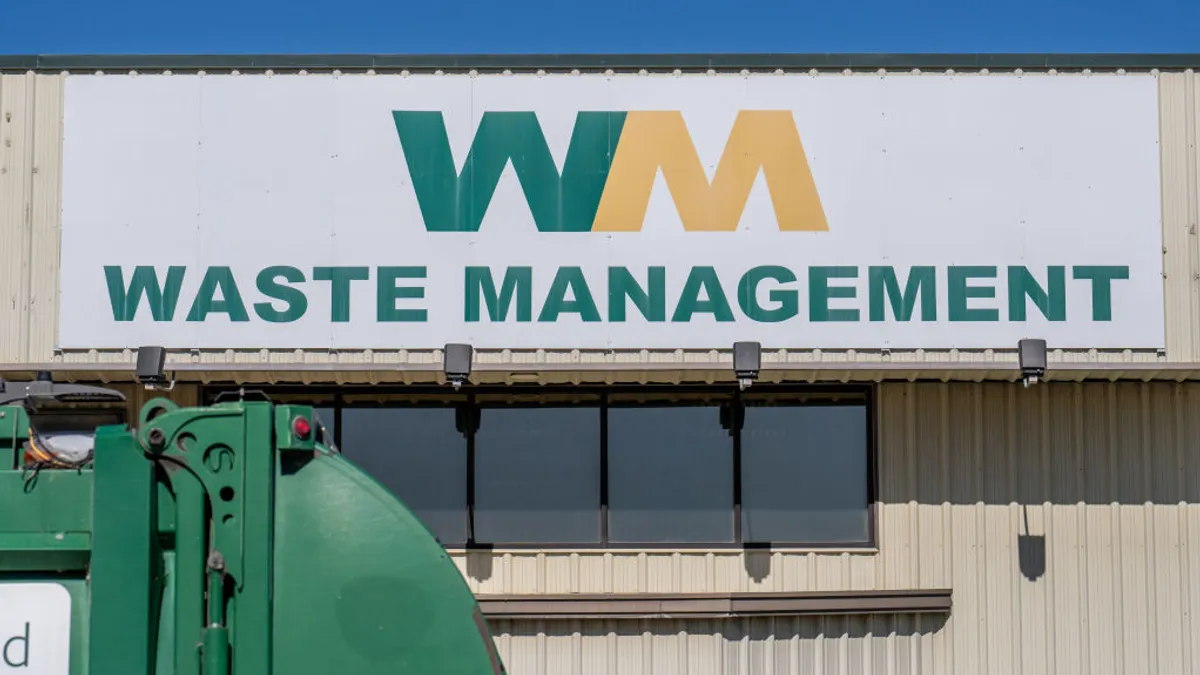As e-cigarette usage surges in the United States, the devices have come under fire for their appeal to youth. But an often overlooked problem is the fire danger they pose for waste and recycling workers. Now, calls for state and federal legislation to better manage these products are growing.
The devices are still relatively new to the United States, so comprehensive data about average product lifespans and amount of e-cigarette waste generated is not available. However, this month the U.S. Centers for Disease Control and Prevention released a study showing e-cigarette sales increased more than 122% from September 2014 to May 2020. The devices’ prices are also shrinking, the CDC says, further driving their proliferation.
One thing that has not kept pace with this sales growth is work on end-of-life solutions for e-cigarettes. Certain kinds are marketed as disposable and consumers throw them in the trash, sometimes after only one use. Other consumers believe the devices' components – metal, plastic and a lithium-ion battery – are recyclable and incorrectly deposit them into recycling bins. Additionally, e-cigarettes — also known as vape pens or vapes — are small, so they may slip into waste and recycling streams by mistake. All of these scenarios present the possibility for a combustion problem across different levels of the supply chain.
“Although not nearly as visible as e-waste, vape-related waste is another important emerging waste stream that local governments and their private sector partners need to manage, and manage properly,” said David Biderman, executive director and CEO of the Solid Waste Association of North America.
No federal or state legislation governing e-cigarette end-of-life disposal currently exists, although some attempts are underway. Recycling and safety advocates say now is the time for action, before the devices’ popularity further expands with negative repercussions.
Safety first
Generally, e-cigarettes are operated by the user pushing a button that heats a liquid-containing plastic cartridge. The devices are not considered a safety hazard under normal conditions, but they do pose a danger when operated in ways not intended by manufacturers or disposed of improperly.
“If you put a whole vape pen in a [collection] box and the button gets pressed, or it gets compressed just right or its battery is punctured, I think certainly the potential is there for a fire,” said Tony Smith, vice president of safety at the Institute of Scrap Recycling Industries (ISRI).
A vape pen’s main safety issue lies in the lithium-ion (Li-ion) battery it contains to fuel the heating element or atomizer. Lithium-ion batteries are quite powerful and spark thermal events, or fires, when they are damaged. The batteries damage easily under pressure, such as squeezing or puncturing, or with friction. The frequent jostling, crushing and shredding in waste and recycling streams can cause battery smoking or combustion of adjacent materials in a collection truck, at MRFs, in scrapyards or at transfer stations.
“They're the toughest batteries for MRFs and haulers because they’re high energy density, small and difficult to identify,” said Carl Smith, CEO and president of nonprofit Call2Recycle. “The big thing we worry about is the puncture and shredding that takes place in waste. That can cause ignition.”
Li-ion batteries still hold a charge even when they appear to no longer be useful, and small charges can cause a thermal event.
“There has been a substantial increase in reported fires at post-collection facilities over the past few years. Lithium-ion batteries are undoubtedly contributing to this increase,” Biderman said.
The thermal dangers are propelling work to expand Li-ion battery recycling options, but it's increasingly common for the batteries to be embedded in devices and hard — or impossible — to remove. This is true in many phones, computers and e-cigarettes that are designed so consumers cannot remove embedded batteries. “It’s a huge problem that’s not going away,” ISRI’s Smith said.
Some consumers do try to remove embedded batteries, but that can damage the battery and make a thermal event more likely. If consumers are successful in removing the battery, they might replace it with a similar one that isn’t suited for the device and still causes a thermal event. Vape pens, for example, contain a common battery, but not all batteries of that size and type are interchangeable.
“It’s one of the most common lithium-ion cells in the marketplace… We see a lot of thermal events when one believes they can take any lithium-ion 18650 and expect it to work equally as well as those sold within the e-cigarette,” said Call2Recycle's Smith.
Although Call2Recycle accepts and recycles batteries, it cannot legally accept intact vapes. Smith said the organization would like to work more with e-cigarettes, but that won’t happen until there’s a way to safely remove the batteries for recycling.
Canadian e-scrap recycler Greentec recently announced a partnership with Auxly Cannabis Group on a free consumer recycling program for vape pens, cartridges and batteries. The recycler said it adheres to strict acceptance criteria to ensure employees’ safety.
“We have specific guidelines for accepting them. If the e-cigarette is damaged or leaking… it needs to be packaged and handled differently,” said Greentec CEO Tony Perrotta. “If it’s at the end of life but intact, we'll take it. If it's broken, that's where the risks happen.”
Requests for vape pen recycling have also increased significantly at Call2Recycle, especially in the past two years. “Before two years ago, I was not even sure what they were, quite frankly. But in the last couple of years, it’s been one of the most — if not the most — popular inquiries,” said Smith.
Despite the difficulties embedded batteries pose in e-cigarettes, they’re also designed that way for a reason: to prevent consumer tampering that results in battery fires.
“Vape manufacturers said they would have more instances of thermal events if they allowed consumers to put in whatever battery they believe is appropriate for it. One way or another, you're going to have to pay a price. That's why this is such a complex issue,” Smith said.
Regulatory wrangling
So far, no states have passed legislation regulating what happens to end-of-life e-cigarettes — but a few have tried.
“Society doesn't have a solution yet for how to keep them out of waste streams,” said Danielle Waterfield, chief policy officer at ISRI. “Policymakers are starting to see there is a problem that needs to be addressed.”
California came the closest to passing sweeping vape legislation in its most recent legislative session, and Maine also made headway. However, that movement has stalled, in part due to complications from the coronavirus overtaking legislators’ agendas.
Maine's bill was one of the rare pieces of legislation introduced to specifically address e-cigarette waste. Most bills are developed to protect consumers’ health from smoking, and disposal considerations are added as clauses. California’s proposed bill banned the sale of single-use electronic cigarettes.
"They're designed for disposal. That's unacceptable, period,” said Heidi Sanborn, executive director of the National Stewardship Action Council, which supported the California bill. “If they’re reusable, you need a takeback or recycling program.”
California’s legislation included requirements for a takeback program or extended producer responsibility (EPR) program.
“The bill would require a manufacturer to collect reusable components that are household hazardous waste, as defined, and send those components to the appropriate recycler, or to reimburse household hazardous waste collection facilities, as defined, for the costs of collecting and recycling those reusable components,” the legislation said.
The EPR model has been popular for e-cigarette products in Canada, where Ontario-based Greentec handles the devices that Auxly collects through its takeback program.
“The good thing is they're not just taking back their own products, but all products. That’s huge on their part,” said Greentec’s Perrotta. “We have EPR regulations here in Canada… I think you’re going to see more and more jurisdictions, provinces and states pass this type of legislation.”
The embedded batteries may complicate the adoption of EPR-style legislation for e-cigarettes and other electronics in the United States.
“If it was just a battery, the manufacturer of the battery would be held responsible. But when it’s an embedded battery, is the battery manufacturer responsible or is the vape manufacturer responsible? Now you have two producers fighting each other,” Waterfield said.
California considers nicotine a hazardous substance and that reportedly has been another barrier for advancing vape legislation. In fact, most states regulate nicotine-related products differently because of their controlled substance status.
Further complicating the equation is that some vapes are used for cannabis consumption. Like nicotine, cannabis is a controlled substance, and cannabis waste is often considered a hazardous material that requires special handling. Therefore, vapes used for cannabis consumption fall into a hazy regulatory area. States must choose whether to address the cannabis factor or simply address the device and not how it is specifically used.
“It shouldn't matter what is in it. It's an electronic that needs to be managed properly,” Sanborn said.
Federal legislation on e-cigarette disposal is also in the works, and similar to state bills, it was not primarily introduced to address device disposal. In this case, a broader plastics management bill mentions vapes due to the disposable cartridges being made of plastic.
Sen. Tom Udall, D-NM, and Rep. Alan Lowenthal, D-Calif., introduced the Break Free From Plastics Pollution Act of 2020 in February. It would set waste and recycling requirements for a variety of plastic products and make certain manufacturers fiscally responsible for end-of-life product management. It also seeks recommendations from participating committees on establishing an EPR program for the vapes and their components.
"The contribution of tobacco-related products to plastic pollution is tremendous, and we want to address that," said Rep. Lowenthal.
The federal bills have stalled for a variety of reasons, including the pandemic halting movement on most pending legislation, as well as questions about drumming up enough support for passing a comprehensive plastics bill in the Republican-controlled Senate.
Lowenthal said his office and Udall's are at the beginning stages of identifying portions of the legislation to update before the bill is reintroduced during the next session of Congress in 2021. Sections dealing with an e-cigarette EPR or redemption program could be among those to be updated.
What’s ahead
Industry participants unanimously agree they expect to see more vape-related legislation introduced in the coming years.
“They're going to be increasingly regulated. There's no question about that,” said Call2Recycle’s Smith.
With that additional regulation, advocates are calling for greater educational programs to inform consumers on how to properly dispose of or recycle the devices.
“It can't just be a regulatory solution. There needs to be education, and it has to originate from the manufacturer first, then maybe it’s communicated by the municipality,” Smith said.
Sources also say legislation alone won’t solve the problem. Greater buy-in and collaboration is needed from all stakeholders, including product manufacturers and the recycling industry.
“Industry is trying to take a lead on this to get stakeholders together and figure out how to keep vapes out of the recycling stream,” ISRI's Waterfield said. “Wouldn't it be great if the manufacturers would design for recycling so these batteries would be safely removable and safely disposed of in the proper collection for lithium-ion batteries?”
Greater numbers of voluntary take-back programs are also expected to appear. Already, some e-cigarette manufacturers have implemented their own initiatives, including Juul's mail-in recycling program. Veolia North America also participated in a recycling program to transport, disassemble and recycle 1.13 million e-cigarette kits, with the nicotine-containing cartridges going to a hazardous material incineration facility in Illinois.
Some local and state governments are beginning to offer limited information about how to handle end-of-life vapes. Washington's Department of Ecology advises residents not to put e-cigarettes in the trash and to dispose of them in accordance with hazardous waste regulations. The Minnesota Pollution Control Agency has similar recommendations for nicotine-containing cartridges, and it advises that rechargeable devices be taken to battery recyclers because disposing of them is illegal in the state.
Last fall, the U.S. Drug Enforcement Administration also began accepting vape pens and cartridges at National Prescription Drug Take Back Day drop-off locations nationwide, with a catch: It won't accept devices containing lithium-ion batteries. The agency encouraged consumers to consult Li-ion battery recyclers, but many of them don't take the devices, either.
Regardless of how the handling of this material evolves, advocates say changes are needed in end-of-life e-cigarette management to protect waste handlers, recyclers and consumers.
“There is currently no possible easy way for people to handle these," Sanborn said. "Then we wonder why it's being mismanaged."



















